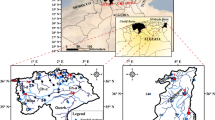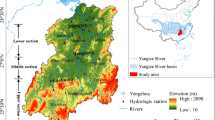Abstract
This paper has studied the change of streamflow and the impact of climatic variability conditions on regional hydrological cycle in the headwater of the Tarim River Basin. This study investigates possible causes of observed trends in streamflow in an environment which is highly variable in terms of atmospheric conditions, and where snow and ice melt play an important role in the natural hydrological regime. The discharge trends of three head streams have a significant increase trend from 1957 to 2002 with the Mann-Kendall test. Complex time-frequency distributions in the streamflow regime are demonstrated especially by Morlet wavelet analysis over 40 years. The purpose is to ascertain the nature of climatic factors spatial and temporal distribution, involved the use of EOF (Empirical Orthogonal Function) to compare the dominant temperature, precipitation and evaporation patterns from normally climatic records over the Tarim’s headwater basin. It shows that the first principal component was dominated since the 1990s for temperature and precipitation, which identifies the significant ascending trend of spatial and temporal pattern characteristics under the condition of the global warming. An exponential correlation is highlighted between surface air temperature and mean river discharge monthly, so the regional runoff increases by 10%–16% when surface air temperature rises by 1°C. Results suggest that headwater basins are the most vulnerable environments from the point of view of climate change, because their watershed properties promote runoff feeding by glacier and snow melt water and their fundamental vulnerability to temperature changes affects rainfall, snowfall, and glacier and ice melt.
Similar content being viewed by others
References
Burn D H, Burn M A, Hag E, 2002. Detection of hydrologic trends and variability. Journal of Hydrology, 255(1–4): 107–122.
Chen Y, Xu Z, 2005. Plausible impact of global climate change on water resources in the Tarim River Basin. Science in China (Series D), 48(1): 65–73.
Corinna Schrum, Mike St. John et al., 2006. ECOSMO, a coupled ecosystem model of the North Sea and Baltic Sea: Part II. Spatial-seasonal characteristics in the North Sea as revealed by EOF analysis. Journal of Marine Systems, 61: 100–113.
David Labat, Yves Goddéris et al., 2004. Evidence for global runoff increase related to climate warming. Advances in Water Resources, 27: 631–642.
Dettinger M D, Diaz H F, 2000. Global characteristics of stream flow seasonality and variability. Journal of Hydrometeorology, 1: 289–310.
Helsel D R, Hirsch R M, 2002. Statistical Methods in Water Resources. U.S. Geological Survey, 323–356.
Houghton J T, Ding Y, Griggs D J, 2001. Climate Change 2001: The Scientific Basis. Cambridge: Cambridge University Press, 4.
Karl T R, Knight R W, Plummer N, 1995. Trends in high frequency climate variability in the twentieth century. Nature, 377: 217–220.
Krasovskaia I, 1995. Quantification of the stability of river flow regimes. Hydrological Sciences Journal, 40(5): 587–598.
Kumar P, 1996. Role of coherent structure in the stochastic dynamic variability of precipitation. Journal of Geophysical Research, 101(26): 393–404.
Kumar P, Foufoula-Georgiou E, 1993. A multicomponent decomposition of spatial rainfall fields. Segregation of large and small scale features using wavelet transform. Water Resource Research, 29(8): 2515–2532.
Labat D, Godderiset Y, Probst J et al., 2004. Evidence for global discharge increase related to climate warming. Advances in Water Resources, 27(6): 631–642.
Lins H F, Slack J R, 1999. Streamflow trends in the United States. Geophysical Research Letters, 26(2): 227–230.
Liu Changming, Xia Jun, 2004. Water problems and hydrological research in the Yellow River and the Huai and Hai river basins of China. Hydrological Processes, 18: 2197–2210.
Liu C, 2004. The issues in the impact study of climate change on the terrestrial hydrological cycle. Advance in Earth Sciences, 19(1): 115–119. (in Chinese)
Marius-Victor Birsan et al., 2005. Streamflow trends in Switzerland. Journal of Hydrology, (314): 312–329.
Pekarova P, Miklanek P, Pekar J, 2003. Spatial and temporal discharge oscillation analysis of the main rivers of the world during the 19th–20th centuries. Journal of Hydrology, 274(1): 62–79.
Pratap Singh et al., 2005. Impact of warmer climate on melt and evaporation for the rainfed, snowfed and glacierfed basins in the Himalayan region. Journal of Hydrology, 300: 140–154.
Risby J S, Entekhabi D, 1996. Observed Sacramento Basin stream flow response to precipitation and temperature changes and its relevance to climate impact studies. Journal of Hydrology, 184(3–4): 209–223.
Shi Y, 2003. An Assessment of the Issuers of Climatic Shift from Warm-Dry to Warm-wet in Northwest China. Beijing: China Meteorological Press, 1–67. (in Chinese)
Singh C V, 2004. Empirical Orthogonal Function (EOF) analysis of monsoon rainfall and satellite-observed outgoing long-wave radiation for Indian monsoon: a comparative study. Meteorology and Atmospheric Physics, 85: 227–234.
Smith L C, Turcotte D L, Isacks B L, 1998. Streamflow characterization and feature detection using a discrete wavelet transform. Hydrological Processes, 12: 233–249.
Storch H, Zwiers F W, 1999. Statistical Analysis in Climate Research. Cambridge: Cambridge University Press.
Wang S, Zhu J, Cai J, 2004. Inter-decadal variability of temperature and precipitation in China since 1880. Advances in Atmospheric Sciences, 21(3): 307–313.
Yang D, Li C, Hu H et al., 2004. Analysis of water resources variability in the Yellow River of China during the last half century using historical data. Hydrological Processes, 40(6): W06502, doi:10.1029/2003WR002763.
Zhang X, Harvey K D, Hogg W D et al., 2001. Trends in Canadian stream flow. Water Resources Research, 37(4): 987–998.
Author information
Authors and Affiliations
Additional information
Foundation: National Natural Science Foundation for Distinguished Young Scholar of China, No.40225004; World Bank Cooperative Project, No.THSD-7
Author: Jiang Yan (1974–), Ph.D., specialized in geographical information system and hydrology.
Rights and permissions
About this article
Cite this article
Jiang, Y., Zhou, C. & Cheng, W. Streamflow trends and hydrological response to climatic change in Tarim headwater basin. J GEOGR SCI 17, 51–61 (2007). https://doi.org/10.1007/s11442-007-0051-8
Received:
Accepted:
Issue Date:
DOI: https://doi.org/10.1007/s11442-007-0051-8




